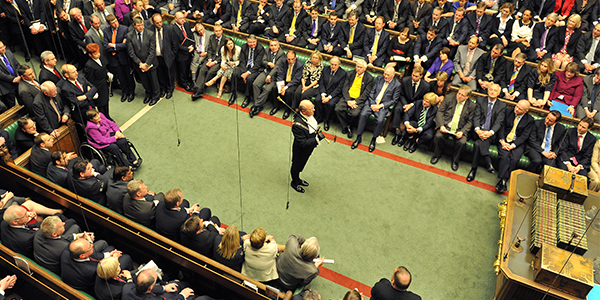Confidence motions, humble addresses and amendments: Brexit’s procedural dilemmas
Brexit has revealed some of the tools that govern the legislative process and how these interact with party politics. Louise Thompson summarises the key procedural dilemmas faced in the Commons so far, and explains why things could get even more complicated in 2019.
 Picture: UK Parliament via a (CC BY-NC-ND 2.0) licence
Picture: UK Parliament via a (CC BY-NC-ND 2.0) licence
As we watch the continued unfolding of the Brexit story and wait to see when (and if) MPs will get to vote on a final deal, media commentary has been awash with talk of confidence motions, humble addresses, and the selection of amendments. The process of scrutinising Brexit has been governed by an often bewildering array of procedural tools. Procedure is complex. The most recent edition of Erskine May, the ‘bible’ of parliamentary procedure on which MPs and clerks rely on a daily basis, runs to over 1000 pages. This sits alongside the House of Commons Standing Orders (another 278 pages), another set of rules and decisions which are crucial to the way in which the House works. What’s been very clear over the last few months is what a powerful weapon procedure can be and how it can be used by the opposition to exert influence over the government.
Labour’s use of the humble address in November 2018 is a good example of this. The Opposition used a fairly archaic procedural device to force the government to release its Brexit legal advice. As Andrew Defty explains, Labour first deployed this tactic just over a year ago, this time to force the government to publish its Brexit impact assessments. The use of the humble address wording in the party’s opposition motion created a ‘motion for return’, whereby the government had to abide by the motion. Thus, when the Attorney General’s legal advice was not published, despite Labour’s successful opposition motion requesting it’s publication the week before, the government found itself in contempt of parliament (see Defty’s explanation again here).
When MPs began debating the withdrawal agreement in the Commons in December, all eyes were on procedure once again in an attempt to work out what might actually happen if the government were defeated. This flow chart put together by the House of Commons showed how many different outcomes there were.
Things were a bit more complex here due to the passage of the Fixed Term Parliaments Act in 2011. The Act requires a very precisely worded confidence motion in order to trigger a general election, despite what some commentators reported. But as the Institute for government’s Catherine Haddon explains, Parliament is still able to pass a motion expressing its disapproval or loss of confidence in the government, just as it would have done in the past. What’s not clear is what the consequences would mean, largely because it depends on how confidence motions are interpreted by those at Westminster.
So procedure may be written down, but the interpretation of what is written can be key. The collection of Points of Order to the Speaker when it became clear that the meaningful vote on the deal was not going to go ahead showed the importance of interpretation. The Speaker was asked by MPs what the Prime Minister had meant when she said she would ‘defer the vote’ – when would it now take place? Would it be a completely new debate, with a new motion? And could the government get around it again? With the help of the Commons’ clerks – the procedural experts who sit directly in front of the Speaker’s Chair – Bercow explained that much of this would depend on the context (whether there was an amended deal to discuss), but even he did not want to take an instant decision on whether there could end up being no parliamentary vote on a no deal Brexit, a question perplexing Labour’s Home Affairs Committee Chair Yvette Cooper.
Then on 12 December we saw the interplay of parliamentary procedure with the party political. The rules of the Conservative Party leadership contest are very clear. Had May lost the vote, we would have seen a leadership election taking place as the Brexit clock continued to tick. As the Prime Minister herself told MPs at PMQs, the time taken up by the election of a new party leader may require a delay or a stop to the Brexit process. As MPs were waiting for the result to be announced, opposition MPs were being asked if and when they will seek a parliamentary vote of no confidence in the Prime Minister. Labour’s Rebecca Long-Bailey has been hesitant about this in the past, but told Andrew Neil last night that there was a possibility of a vote, but that the party was considering timing and discussing their options with other parties on both sides of the House.
The Prime Minister may have survived her party’s attempt to remove her, but we may yet be faced with more procedural dilemmas if we do see a confidence motion on the floor of the House before Christmas. As Catherine Haddon has noted, the ambiguity of the Fixed Term Parliaments Act makes it unclear what would happen in the event of a successful no confidence motion, meaning that things could still get very complicated as we move into the New Year.
This article gives the views of the authors, and not the position of Democratic Audit. It was first published on the LSE’s British Politics and Policy blog.
About the author
 Louise Thompson is Senior Lecturer in Politics at the University of Manchester.
Louise Thompson is Senior Lecturer in Politics at the University of Manchester.






 Democratic Audit's core funding is provided by the Joseph Rowntree Charitable Trust. Additional funding is provided by the London School of Economics.
Democratic Audit's core funding is provided by the Joseph Rowntree Charitable Trust. Additional funding is provided by the London School of Economics.